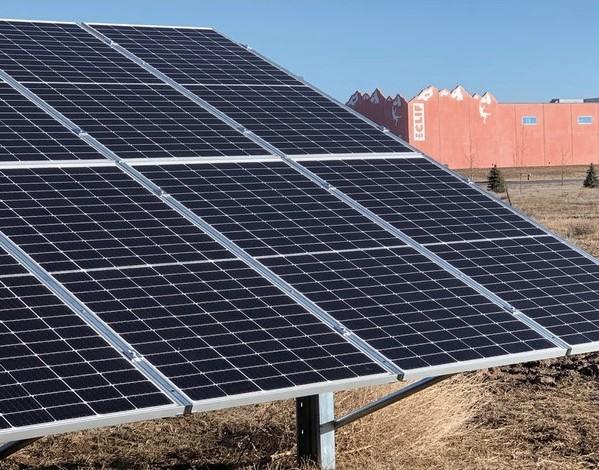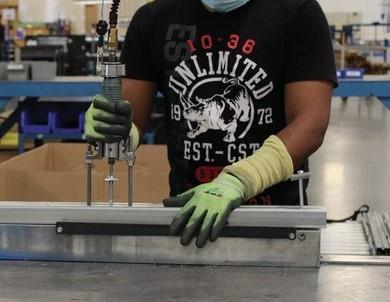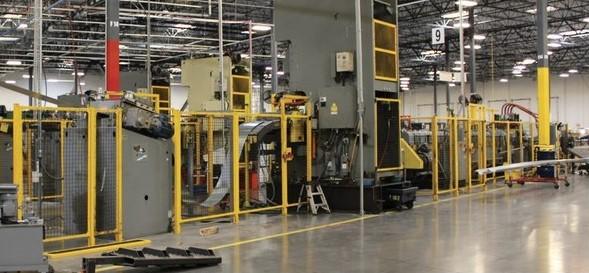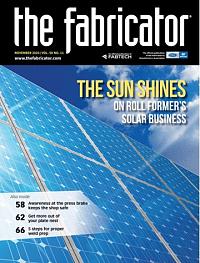Senior Editor
- FMA
- The Fabricator
- FABTECH
- Canadian Metalworking
Categories
- Additive Manufacturing
- Aluminum Welding
- Arc Welding
- Assembly and Joining
- Automation and Robotics
- Bending and Forming
- Consumables
- Cutting and Weld Prep
- Electric Vehicles
- En Español
- Finishing
- Hydroforming
- Laser Cutting
- Laser Welding
- Machining
- Manufacturing Software
- Materials Handling
- Metals/Materials
- Oxyfuel Cutting
- Plasma Cutting
- Power Tools
- Punching and Other Holemaking
- Roll Forming
- Safety
- Sawing
- Shearing
- Shop Management
- Testing and Measuring
- Tube and Pipe Fabrication
- Tube and Pipe Production
- Waterjet Cutting
Industry Directory
Webcasts
Podcasts
FAB 40
Advertise
Subscribe
Account Login
Search
Roll forming for solar shines bright at OMCO
Bet on becoming a solar OEM pays off for Ohio fabricator
- By Tim Heston
- November 18, 2020
- Article
- Roll Forming

Held with mounting products from OMCO Solar, these solar panels provide a portion of the Pierceton, Ind., plant's electricity. They also serve as an R&D site and customer showroom. Images provided by OMCO
OMCO, one of the country’s major roll forming players, experienced the early days of the COVID-19 recession like most fabricators. The 350-employee company instituted face mask protocols, rearranged assembly cells, got to know Zoom, and limited the office population to support physical distancing.
Work at the four-plant operation, headquartered in Wickliffe, Ohio, could have slowed significantly. Decreased demand in some of its core markets—transportation, material handling, and other general industrial sectors—has hammered other fabricators across the country. But OMCO didn’t experience such a dramatic drop.
“We’ve been insanely busy.”
So said Eric Goodwin, director of business development at OMCO Solar, a division that in 2019 accounted for about 10% of OMCO’s overall revenue. In 2020 solar’s share could climb as high as 35%.
He added, though, that those in the solar business call it the “solar coaster” for a reason. The sector’s known for its ups and downs. But at OMCO, at least, “the growth hasn’t shown any signs of letting up.”
“Our contract work has been affected by the recession,” said Andy Kinkade, operations manager at OMCO’s Pierceton, Ind., facility, “but the growth in solar has definitely helped make the downturn less severe than it would have been.”
OMCO Solar, based in Phoenix, has evolved significantly since it launched as a small contract roll forming operation in 2007. In fact, today it’s not a contract operation at all but instead an OEM that designs, builds, and markets its own solar panel mounting products, some of which are in use outside its Pierceton plant. The array provides a portion of the plant’s electricity, but it’s also a customer showroom and a place to test new product designs.
The transition from contract to OEM in solar didn’t happen overnight. Moreover, OMCO’s contract operations still represent a larger share of the company’s revenue. The organization has become an OEM and contract roll forming hybrid, effectively two business models rolled into one (pun intended). How that hybrid has evolved might show just how complementary those business models can be.
The Contract Roll Former
Most players in the solar mounting systems business outsource the roll forming and at least a portion of their assembly operations. Why? One reason is the solar coaster, but it also has to do with the nature of the manufacturing process itself.
Roll forming isn’t a business for button-pushers. Operators need to know what they’re doing. Each toolset at each roll stand forms a workpiece incrementally into a continuous profile, and controlling how the tools and workpiece interact is a subtle art. As sheet metal is coil-fed into the machine, its thickness and other properties can change not just between coils but also throughout the coil itself—and the operator needs to adjust accordingly.
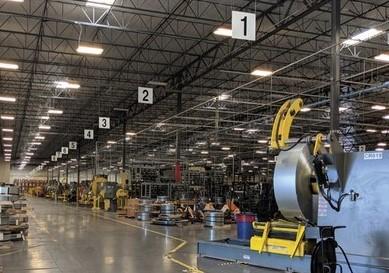
Roll forming lines are numbered at Pierceton, Ind., plant. OMCO has 50 roll forming lines across four plants.
Operations dedicated to contract work are mainly in OMCO’s Ohio and Indiana plants. Among the company’s dozens of roll mills (there are more than 50 companywide), you might see a setup tech watching an operator inserting a feeler gauge between the rolls, verifying the roll gap. There’s an important distinction here: The operator, not the setup tech, has the feeler gauge.
Kinkade clarified the setup techs’ role. “Their official title might be ‘setup technician,’ “but they do not perform setups. As technical experts with 20 or 30 years of roll forming experience, they might assist with a challenging setup where an operator might be struggling. But our operators perform the setups.”
OMCO’s contract and custom roll forming operation is built upon the company’s certified roll forming specialist, or CRS. To operate any roll forming machine, new employees receive training that makes them a Level I CRS. Level I training means these new operators are certified to set up and run small and simple mills: straightforward roll profiles with wide tolerances; no sweeps; and no complicated hole punching before (prenotching or prepunching) or after (postpunching) the roll mill; and no other integrated secondary operations. More complicated setups are reserved for operators with Level II, III, or IV certifications, which they can obtain with more training and experience.
Most critically, OMCO’s team of CRSs aren’t organized in a pyramid, with fewer open positions as operators climb their career ladder. “Every roll forming operator we hire has the opportunity to become a Level IV roll forming specialist, even if they’re not performing Level IV work on a daily basis,” Kinkade said. “We incentivize people to become more knowledgeable and to be able to run the most complex roll forming lines in the factory.”
The contract roll forming business model benefits greatly from such training, mainly because it helps OMCO deal with a range of challenges. Many of these challenges are discussed in weekly meetings that involve engineering, purchasing, operations management, and the operators themselves. “We get our best information from the operators,” Kinkade said.
For instance, operators might find that coil from a certain supplier varies in thickness or hardness in ways that spur serious irregularities in setup. Personnel in purchasing and management listen and, when possible, take action to resolve the problem.
As operators achieve higher certification levels and gain more experience, they give insights into manufacturability. For instance, a workpiece might have holes placed in a way that requires variable feed lengths (such as several short feeds followed by longer ones) into the prepunch press before the strip enters the loop (the slack between the prepunch and entry rolls). Unfortunately, because the hole placement requires short feed lengths in succession through the prepunch, the operator has no choice but to slow the line speed.
Run the line too quickly and the loop would lose its slack, become taut, and wreak havoc on the roll form mill’s ability to form the profile. If the holes were rearranged in the right way, though, the operator could ramp up the line speed significantly while maintaining sufficient slack in the loop. Similar design-for-manufacturability (DFM) thinking applies for part tolerances and other features close to bend radii, the need for more (or fewer) roll stands to achieve a given profile—the list goes on.
In contract roll forming, a part design change may or may not be possible. As anyone who works in custom or contract manufacturing knows, a company’s ability to make an existing design work as is can be a major selling point. OMCO engineers will of course suggest money-saving design changes, but they also push their in-house team to overcome technical challenges.
Becoming a Solar OEM
In recent years Kinkade has helped integrate roll forming production of solar products into OMCO plants beyond the Phoenix facility, which has been dedicated to the solar industry since the division launched in 2007. “I found that our own product line has been one of the easiest to integrate into our other factories,” he said.
There’s a good reason for that. Because OMCO Solar is vertically integrated, engineers have designed its mounting products with manufacturability in mind. On the contract side, operators process a range of materials of different thicknesses and hardnesses, as well as a variety of part geometries. The setup complications abound.
To accommodate for this, five roll form lines at the Indiana plant are rafted: three are for 2.5-in. profiles, one is for 3.5-in. profiles, and another is a 4-in. line. A crane lifts entire sections of preset roll tooling. There’s no need to spend hours organizing, orienting, and aligning upper and lower rolls and spacers at every roll stand.
The company’s solar products, on the other hand, consist of a limited range of materials and thicknesses, mostly 10- or 11-ga. carbon steel. The products are designed for ease of setup and roll forming consistency, no Level IV roll technician required.
Such control over product design was one reason OMCO Solar decided to make the shift toward its own product line back in 2015. It was a bold move, especially considering OMCO’s prior success in solar as a contract supplier.
“Between 2009 and 2015, we deployed just about 8 gigawatts of solar power collectively in projects in the U.S. and around the world,” OMCO Solar’s Goodwin said. “We worked with projects in Chile, India, and Australia, all shipped from our plants in the U.S.”
In the early 2010s, though, OMCO’s customer mix in solar began to shift. It always had a range of smaller customers (like the “long tail” of many a job shop’s order mix), but one major customer took a different supply chain strategy. At that point the roll former could have hit the pavement and worked to fill the void with additional contract work in the solar arena and elsewhere.
But the organization had learned a lot during the solar division’s short history. Aside from one company in the Midwest, no other solar panel mounting system OEM had in-house roll forming. In fact, many relied on their suppliers to do a fair amount of assembly and supply chain management. Such a sourcing strategy made sense, considering the market realities of the solar coaster, the high capital equipment costs necessary to build roll forming capacity, and the talent needed to run the machines. Roll forming techs with decades of experience don’t just come walking in the door.
But OMCO already had the roll forming expertise and capacity. It also had a customer base diverse enough to absorb the solar coaster’s ups and downs. It could dedicate the lines in Phoenix to its solar products, but to scale up further, it could rely on its dozens of other roll mills in Indiana and Ohio. And because it would have design control, it could maximize its roll forming efficiency.
Consider the hole placement challenge for the prepunch operation. In contract work a hole might need to be in a certain location, no matter what. Operators and engineers do their best to accommodate but might have to live with a slower line speed—say, 20 feet per minute. With their own product line, though, OMCO engineers work with designers to optimize hole placement so they can run their product at more than twice the speed. Their own products also can be designed for simple setup. The result: Mills can alternate between OMCO’s product line and contract work.
Finally, such extensive in-house roll forming made it practical to offer customers in the solar market more customizations—no need to design a solar array around specific lengths or other standard products from a catalog. OMCO could, say, roll form torque tubes (the central lateral component that supports OMCO’s solar tracker) to customized, longer lengths. This would give installers fewer pieces to work with on-site. Just like any construction project, the less on-site work you have, the better.
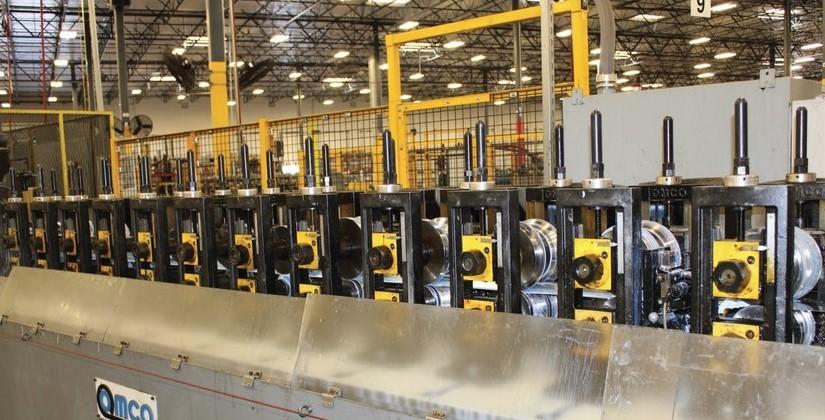
Roll form lines in Pierceton can be tooled up to produce solar products as well as a range of contract work.
Considering all this, OMCO management decided to make the shift toward becoming a solar OEM. Because of the company’s history as a contract player, the move had to be well-planned and not a secret.
“For our existing contract customers, the move put us in a competitor position,” Goodwin said. “When we made the decision to shift from being a contract manufacturer to an OEM, we told all of our solar customers about a year and a half in advance. We were very open about it, and most of our customers understood.”
Along with this came a significant retooling of the Phoenix plant in 2015. “At the time we had very robust markets in our transportation and industrial sectors that gave us a chance to take the time we needed to retool our solar business,” Goodwin said.
The roll forming mills there had been set up for contract work in the solar market. For instance, its assembly cells were tailored for the kinds of subassemblies solar customers demanded. This made Phoenix distinct from other OMCO sites, and it would only become more distinct over the next few years.
OMCO Solar employees’ jobs became more specialized. The Phoenix plant had dedicated parts catchers who took completed roll form parts to assembly. To ramp up throughput, each assembly cell had more employees, each of whom was dedicated to a specific job.
Sources emphasized that the company encourages cross-training, so employees might move between different machine operation, material handling, and assembly positions. But because the operation was now an OEM, the value chain—from coil stock through roll forming, part transfer, assembly, quality assurance, and shipping—became much more segmented.
A Manufacturing Hybrid
As OMCO entered the solar market as an OEM, its in-house roll forming and fabrication capacity was a key selling point for customers. It could offer unique designs incorporating the concepts of unitization (fewer parts to assemble) and errorproof assembly (components go together only one way).
The company started offering its first fixed-tilt systems in 2015. In late 2019 it delved into trackers that, as their name implies, follow with the sun throughout the day. Beyond the roll formed and fabricated components, these products incorporate software, control hardware, and drive systems. Save for a motor drive from Asia (purchased through a U.S.-based parent company), all purchased components come from the U.S.
Since 2018 OMCO has been planning for increased demand in solar. To increase its roll forming capacity, it adapted existing lines in Indiana to the solar product. It also added a solar roll form line to its custom fabrication plant in Talladega, Ala.
Both OMCO’s contract and solar OEM work has benefited from recent technology upgrades. For instance, the operation has upgraded many of its flying dies to accelerated dies for part cutoff and punching operations. Accelerated dies connect with the system via an encoder so that it “knows” where the part is, moves in concert with the strip without contacting it, and, as a result, can make a clean, accurate cut with less distortion and at higher line speeds.
In recent weeks operations managers discussed the potential of acquiring technology entirely new to the Indiana facility: automated part handling and palletizing. In the contract world, end-of-line automation didn’t make sense, considering the broad, unpredictable part mix. Now that solar volumes are climbing, automation is an option.
Some roll form lines for solar produce long parts that weigh nearly 100 lbs., and at this writing, the company was looking into mechanized systems that could transport and palletize these large parts as they come off the line. Of course, flexibility is a necessity. Considering the company’s need to run both contract and solar work, the roll form line needs to be able to run both with and without the part-offload automation.
A Changing Shop Floor
Now that more solar work has permeated OMCO’s Midwest plants, the nature of those operations is also changing, and the knowledge-sharing abounds. For instance, techniques in solar product assembly have been applied to contract work, more of which now includes some level of assembly.
Now that solar production and contract roll forming share the same factory floors, managers work diligently not just on technology options and the sharing of best practices, but also the cultural considerations.
“I meet with managers and supervisors three or four times a week on this very subject,” Kinkade said. “We need to make sure everyone understands, just because it’s different doesn’t make it bad. What we don’t want is a silo mentality.”
Opportunity for cross-training remains key to it all. The production jobs might be different from the contract manufacturing jobs. Duties may be more segmented for solar production, simply because of the nature of the work. Regardless, Kinkade said, the opportunity to learn remains a common thread.
“It takes a team to accomplish something well,” Kinkade said, “and people need to feel they’re a valuable member of the team. And even if [a certain challenge] is outside your realm, we still want to hear your input on improvement.
“We always make sure people have the opportunity to cross-train,” he added. “We need to make sure everyone has the tools they need to succeed, and one of the greatest tools is knowledge.”
About the Author

Tim Heston
2135 Point Blvd
Elgin, IL 60123
815-381-1314
Tim Heston, The Fabricator's senior editor, has covered the metal fabrication industry since 1998, starting his career at the American Welding Society's Welding Journal. Since then he has covered the full range of metal fabrication processes, from stamping, bending, and cutting to grinding and polishing. He joined The Fabricator's staff in October 2007.
Related Companies
subscribe now

The Fabricator is North America's leading magazine for the metal forming and fabricating industry. The magazine delivers the news, technical articles, and case histories that enable fabricators to do their jobs more efficiently. The Fabricator has served the industry since 1970.
start your free subscription- Stay connected from anywhere

Easily access valuable industry resources now with full access to the digital edition of The Fabricator.

Easily access valuable industry resources now with full access to the digital edition of The Welder.

Easily access valuable industry resources now with full access to the digital edition of The Tube and Pipe Journal.
- Podcasting
- Podcast:
- The Fabricator Podcast
- Published:
- 04/16/2024
- Running Time:
- 63:29
In this episode of The Fabricator Podcast, Caleb Chamberlain, co-founder and CEO of OSH Cut, discusses his company’s...
- Trending Articles
Capturing, recording equipment inspection data for FMEA

Tips for creating sheet metal tubes with perforations

Are two heads better than one in fiber laser cutting?

Supporting the metal fabricating industry through FMA

Omco Solar opens second Alabama manufacturing facility

- Industry Events
16th Annual Safety Conference
- April 30 - May 1, 2024
- Elgin,
Pipe and Tube Conference
- May 21 - 22, 2024
- Omaha, NE
World-Class Roll Forming Workshop
- June 5 - 6, 2024
- Louisville, KY
Advanced Laser Application Workshop
- June 25 - 27, 2024
- Novi, MI
























